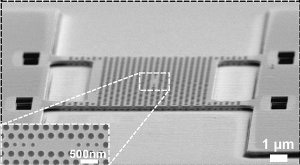Dec 21 2017
 An electron microscope image of the perforated membrane with the crystal cavity in the middle. Detail: the crystal cavity which captures light. Credit: TU Eindhoven
An electron microscope image of the perforated membrane with the crystal cavity in the middle. Detail: the crystal cavity which captures light. Credit: TU Eindhoven
An innovative spectrometer, small enough to be inexpensively and easily incorporated into a smartphone, gets us one step closer to checking whether food is fresh, the quality of ambient air, or whether a lump is malignant. The tiny sensor fabricated at TU Eindhoven is very accurate similar to the usual tabletop models adopted in scientific labs. The scientists have reported about their invention in the Nature Communications journal on December 20, 2017.
Spectrometry, or the investigation of invisible and visible light, finds a broad array of applications. With respect to light absorption or reflection, every individual material or tissue has a unique “footprint”, and hence can be identified by using spectrometry. However, accurate spectrometers are very huge because they split up the light into distinct colors, or frequencies, which are then separately evaluated. Immediately following the splitting up of light, the beams (having distinct frequencies) are still overlapped on each other. Therefore, highly accurate evaluations can be made only tens of centimeters after the splitting.
The Eindhoven team created an innovative sensor with the ability to carry out such accurate evaluations in an absolutely distinct manner by adopting an unusual “photonic crystal cavity”—a “trap” measuring only a few micrometers where the light falls in and cannot escape. This trap is incorporated in a membrane, where the trapped light produces a feeble electrical current, which is measured. Žarko Zobenica, PhD student, designed the cavity such that it is highly accurate, maintaining only a very small frequency interval and hence measuring light only at that frequency.
In order to be in a position to measure a larger frequency range, the team positioned two of the membranes one over the other very close. The two membranes had an impact on one another—when the distance between them is slightly altered, the light frequency that the sensor could detect also gets altered. Therefore, the team, under the supervision of professor Andrea Fiore and associate professor Rob van der Heijden, included a micro-electromechanical system (MEMS). This system enables the distance between the membranes to be altered, eventually altering the measured frequency. Finally, the sensor covers a wavelength range of nearly 30 nm, where the spectrometer can identify nearly hundred thousand frequencies, which is extremely accurate. This is rendered feasible by the fact that the team could accurately ascertain the distance between the membranes to be only a few tens of femtometers, or 10-15 m.
In order to exhibit its functionality, the team showed various applications, such as a gas sensor. They also developed an exceptionally accurate motion sensor by skillfully exploiting the fact that the detected frequency gets altered if the two membranes move with respect to each other.
Professor Fiore anticipates that the actual incorporation of the innovative spectrometer into a smartphone might take more than 5 years as the frequency range covered at present is very small. Currently, the sensor covers only a meagre portion of the near-infrared spectrum, which is the most common spectrum. Therefore, he will be working along with his colleagues to expand the detectable spectrum. They will also incorporate an extra element with the micro-spectrometer, which is a light source with the ability to render the sensor independent of external sources.
Due to the expansive array of applications, micro-spectrometers are anticipated to ultimately turn out to be a significant element of the smartphone, similar to the camera. For instance, to determine the medicine that you have, to measure CO2, to ascertain your blood sugar level, to detect smoke, to evaluate the freshness of food, and other applications.